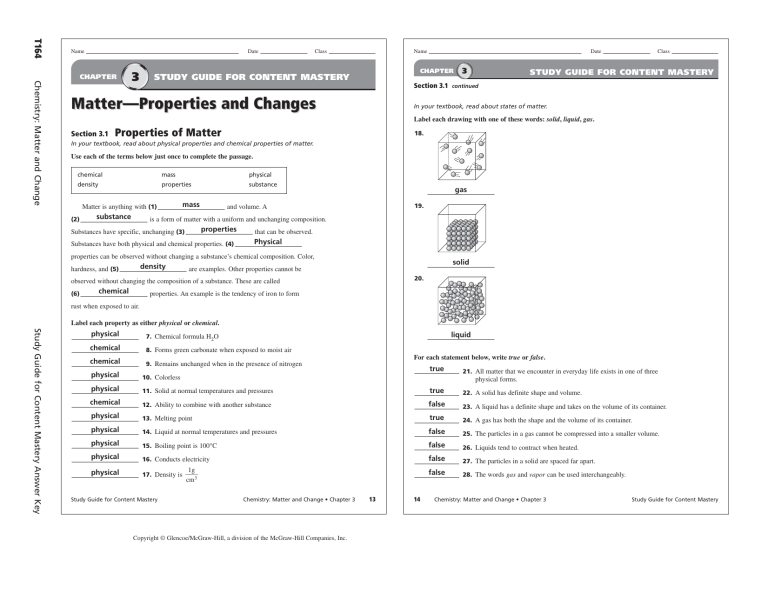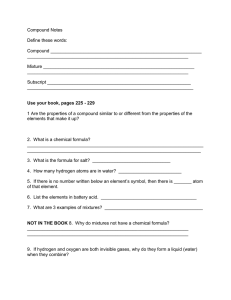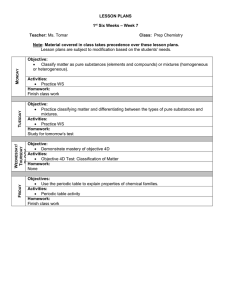
T164 Name Date Chemistry: Matter and Change CHAPTER 3 Class Name Date CHAPTER STUDY GUIDE FOR CONTENT MASTERY 3 Class STUDY GUIDE FOR CONTENT MASTERY Section 3.1 continued Matter—Properties and Changes In your textbook, read about states of matter. Label each drawing with one of these words: solid, liquid, gas. Section 3.1 Properties of Matter 18. In your textbook, read about physical properties and chemical properties of matter. Use each of the terms below just once to complete the passage. chemical mass physical density properties substance Matter is anything with (1) (2) substance mass gas 19. and volume. A is a form of matter with a uniform and unchanging composition. properties Substances have specific, unchanging (3) Substances have both physical and chemical properties. (4) that can be observed. Physical properties can be observed without changing a substance’s chemical composition. Color, density hardness, and (5) solid are examples. Other properties cannot be 20. observed without changing the composition of a substance. These are called (6) chemical properties. An example is the tendency of iron to form rust when exposed to air. Label each property as either physical or chemical. Study Guide for Content Mastery Answer Key physical 7. Chemical formula H2O chemical 8. Forms green carbonate when exposed to moist air chemical 9. Remains unchanged when in the presence of nitrogen liquid For each statement below, write true or false. true 21. All matter that we encounter in everyday life exists in one of three 11. Solid at normal temperatures and pressures true 22. A solid has definite shape and volume. chemical 12. Ability to combine with another substance false 23. A liquid has a definite shape and takes on the volume of its container. physical 13. Melting point true 24. A gas has both the shape and the volume of its container. physical 14. Liquid at normal temperatures and pressures false 25. The particles in a gas cannot be compressed into a smaller volume. physical 15. Boiling point is 100°C false 26. Liquids tend to contract when heated. physical 16. Conducts electricity false 27. The particles in a solid are spaced far apart. physical 1g 17. Density is ᎏ cm3 false 28. The words gas and vapor can be used interchangeably. physical 10. Colorless physical Study Guide for Content Mastery physical forms. Chemistry: Matter and Change • Chapter 3 Copyright © Glencoe/McGraw-Hill, a division of the McGraw-Hill Companies, Inc. 13 14 Chemistry: Matter and Change • Chapter 3 Study Guide for Content Mastery Copyright © Glencoe/McGraw-Hill, a division of the McGraw-Hill Companies, Inc. Study Guide for Content Mastery Answer Key Name Date CHAPTER Section 3.2 3 Class Name STUDY GUIDE FOR CONTENT MASTERY Changes in Matter Date CHAPTER Section 3.3 3 STUDY GUIDE FOR CONTENT MASTERY Mixtures of Matter In your textbook, read about physical change and chemical change. In your textbook, read about pure substances and mixtures. What kinds of changes do these words indicate? Write each word under the correct heading. Use each word only once. Use the words below to complete the concept map. boil crumple crush explode burn ferment freeze grind condense melt oxidize rot corrode rust tarnish vaporize Class heterogeneous salt–water mixture sand–water mixture mixtures solutions water matter Physical Change Chemical Change boil 1. 9. substances explode 2. freeze 10. rust 3. condense 11. oxidize 4. vaporize 12. corrode 5. melt 13. tarnish 6. grind 14. ferment 7. crumple 15. burn 8. crush 16. rot 2. water 1. 3. mixtures heterogeneous homogeneous mixtures mixtures 4. sand–water mixture solutions 5. 6. salt–water mixture For each item in Column A, write the letter of the matching item in Column B. Column A Column B Chemistry: Matter and Change c 17. The new substances that are formed in a chemical reaction a. chemical change In your textbook, read about separating mixtures. a 18. A chemical reaction that involves one or more substances b. reactants For each item in Column A, write the letter of the matching item in Column B. changing into new substances d c. products 19. Shows the relationship between the reactants and products in a chemical reaction e b 20. States that mass is neither created nor destroyed in any process Column A b d. chemical equation 7. Separates substances on the basis of the boiling points of the substances e. law of conservation of mass c 21. The starting substances in a chemical reaction 8. Separates by formation of solid, pure particles from a solution d Answer the following question. Write an equation showing conservation of mass of reactants and products. 9. Separates substances based on their movement through a Column B a. filtration b. distillation c. crystallization d. chromatography special paper a 22. In a laboratory, 178.8 g of water is separated into hydrogen gas and oxygen gas. The 10. Separates solids from liquids by using a porous barrier hydrogen gas has a mass of 20.0 g. What is the mass of the oxygen gas produced? Masswater Masshydrogen Massoxygen; 178.8 g water 20.0 g hydrogen Massoxygen ; Massoxygen 178.8 g – 20.0 g; Massoxygen 158.8 g T165 Study Guide for Content Mastery Chemistry: Matter and Change • Chapter 3 15 16 Chemistry: Matter and Change • Chapter 3 Study Guide for Content Mastery T166 Name Date 3 CHAPTER Class Name STUDY GUIDE FOR CONTENT MASTERY Date CHAPTER 3 Class STUDY GUIDE FOR CONTENT MASTERY Chemistry: Matter and Change Section 3.4 continued Section 3.4 Elements and Compounds 18. Sucrose is 51.50% oxygen. How many grams of oxygen are in 20.0 g of sucrose? Show your work. In your textbook, read about elements and compounds. 51.50% oxygen Massoxygen/20.0 g sucrose 100%; Circle the letter of the choice that best completes the statement or answers the question. 51.50% oxygen 20.0 g sucrose/100% Massoxygen 10.3 g 1. A substance that cannot be separated into simpler substances by physical or chemical means is a(n) 19. A 2-g sample of sucrose is 6.50% hydrogen. What is the mass percentage of hydrogen in a. compound. b. mixture. c. element. d. period. 300 g of sucrose? Explain your reasoning. 6.50%; because the mass percentage is consistent regardless of the amount 2. A chemical combination of two or more different elements is a(n) a. solution. b. compound. c. element. of sucrose d. period. 3. Which of the following is an example of an element? a. water b. air 20. Two compound samples are found to have the same mass percentages of the same ele- c. sugar ments. What can you conclude about the two samples? d. oxygen They are the same compound. 4. Which of the following is an example of a compound? a. gold b. silver c. aspirin d. copper In your textbook, read about the law of multiple proportions. 5. What are the horizontal rows in the periodic table called? a. block elements b. groups or families c. grids Use the law of multiple proportions to answer the questions and complete the table below. d. periods 6. What are the vertical columns in the periodic table called? a. block elements b. groups or families c. grids The law of multiple proportions states that if the elements X and Y form two compounds, the different masses of Y that combine with a fixed mass of X can be expressed as a ratio of small whole numbers. d. periods Label each substance as either an element or a compound. element compound Study Guide for Content Mastery Answer Key element 7. silicon 8. sodium chloride element compound 21. Two compound samples are composed of the same elements, but in different proportions. 10. nickel What can you conclude about the two samples? 11. ice They are not the same compound. 9. francium For each compound in the table, fill in the ratio of the mass of oxygen to the mass of hydrogen. Write the symbol for each element. Use the periodic table on pages 72–73 in your textbook if you need help. Ne 12. neon Ti 15. titanium Ca 13. calcium F 16. fluorine Fe 14. iron Compound In your textbook, read about the law of definite proportions. Mass of Oxygen Mass of Hydrogen Mass O/Mass H H2O 16 g 2g 22. 8 g O/1 g H H2O2 32 g 2g 23. 16 g O/1 g H 24. Write a brief statement comparing the two mass ratios from the table. The mass ratio of oxygen to hydrogen in H2O2 is two times the mass ratio of Use the law of definite proportions and the equation below to answer the questions. The law of definite proportions states that regardless of the amount, a compound is always composed of the same elements in the same proportion by mass. oxygen to hydrogen in H2O. This follows the law of multiple proportions. mass of element ⫻ 100% Mass percentage of an element (%) ⫽ ᎏᎏ mass of compound 25. Are H2O and H2O2 the same compound? Explain your answer. No; they have different proportions of hydrogen and oxygen. 17. A 20.0-g sample of sucrose contains 8.4 g of carbon. What is the mass percentage of car- bon in sucrose? Show your work. 8.4 g carbon/20.0 g sucrose 100% 42.00% carbon Study Guide for Content Mastery Chemistry: Matter and Change • Chapter 3 Copyright © Glencoe/McGraw-Hill, a division of the McGraw-Hill Companies, Inc. 17 18 Chemistry: Matter and Change • Chapter 3 Study Guide for Content Mastery


